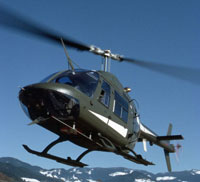|

|
|

|
The Bell
Helicopter Model 206 JetRanger is a two-bladed main rotor, turbine
powered helicopter with a conventional, two-bladed tail rotor. The
aircraft uses hydraulic boosted flight controls.
In October 1961, the Army submitted a request for proposals (RFP) for
the Light Observation Helicopter (LOH). Bell, along with 12 other
manufacturers (including Fairchild-Hiller and Hughes Tool Co. Aircraft
Division), entered the competition. Bell submitted their design for
Model 206, which was selected out of the design phase of the Navy-run
competition by the Army and designated as the YHO-4A.
Bell produced five prototype aircraft in 1962 to submit to the army
for the test and evaluation phase. During the testing phase, the test
pilots complained about the power problems of the aircraft, an issue
that apparently knocked it out of the running, because when the
winners were announced to progress on to the final selection phase,
Bell's YOH-4A wasn't selected. Afterwards, Bell attempted to market
the model 206, but it didn't fare well commercially. Bell's market
research showed that it was the body design that customers found
mostly unpalatable. Bell redesigned the fuselage of the airframe to be
more sleek and aesthetic, and reintroduced it as Model 206A JetRanger
which was a commercial success.
The 206A, and B are five-seat designs, with two seats in the front and
a three seat bench in the back.
|
BELL 206 Specifications |
|
Type |
Light Utility
Helicopter |
|
Manufacturer |
Eurocopter |
|
Accommodation |
One crew plus four
passengers |
|
Armament |
None |
|
Performance |
Max
Speed 139mph (224km/h) |
|
Main Rotor Diameter |
33ft 4in (10.2m) |
|
Length |
3 ft (12m) |
|
Height |
9ft 4in (2.83m) |
|
Weight |
weight empty 1,632lb (740kg), Max take off
weight 3,350lb (1,500kg) |
|
Powerplant |
One Allison 250-C20J turboshaft producing
420shp (313kW) |
|
Variants |
206B/C/L-2/L-3 |
|